
* In the early 1960s, the French Nord firm introduced a twin-turboprop transport, the "Nord 262", which was built in limited numbers. A decade later, the Czech Let firm introduced another twin-turboprop transport, the "L-410", which proved more popular, particularly in Russian service. In the decade after that, the Swedish SAAB firm introduced yet another twin-turboprop transport, the "SAAB 340", which also proved popular. This document provides a history and description of these three European twin-turboprop airliners.
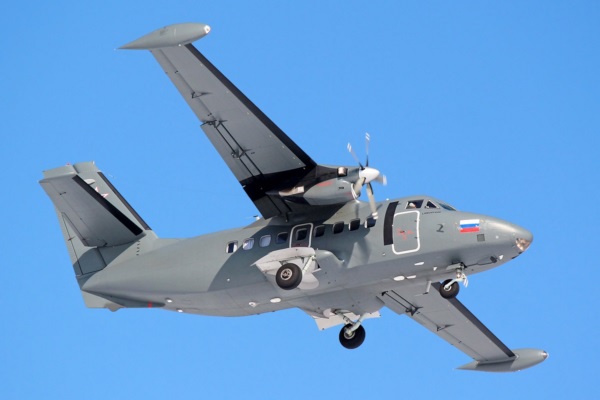
* In the late 1950s, French aircraft designer Max Holste decided to design a new twin-prop transport to replace the ubiquitous Douglas DC-3 / C-47, the result being the "MH.250 Super Broussard". It performed its initial flight on 20 May 1959; it had a boxy fuselage and was powered by twin Pratt & Whitney Wasp radials. A second prototype followed it into the air on 29 July 1960, this machine being fitted with Turbomeca Bastan turboprops with 730 kW (980 HP) each.
Further development of the aircraft was taken over by the state-owned Nord Aviation firm, which altered the design with a pressurized cabin featuring a circular cross-section, the result being designated the "Nord 262". The initial flight of the prototype was on 24 December 1962, with the machine displayed at the June 1963 Paris Air Show; it was certified in the summer of 1964, to then enter service. The initial production version was the "N.262B", which was powered by twin Bastan VIC turboprops. Only four were built, all going to Air Inter. Confusingly, the N.262B was followed in production by the generally similar "N.262A", also with Bastan VIC engines.
The N.262A was of metal construction, being primarily made of aircraft aluminum alloy, with fabric-covered flight control surfaces. It had high-mounted tapered two-spar wings, plus a tapered tailplane and tailfin, the tailplane being mid-mounted, the tailfin having a prominent forward fillet. Flight surface arrangement was conventional, with ailerons, two-section flaps, elevators, rudder, and trim tabs. There were pneumatic de-icing boots on the outer wings.
The Bastan IVC engines provided 805 ekW (2,080 EHP) each and drove 3-bladed variable-pitch propellers. There were three bag fuel tanks in each wing, providing a total fuel capacity of 2,000 liters (528 US gallons); two more bag tanks could optionally be fitted in the wing center section, each providing 203 liters (54 US gallons).
The N.262A had tricycle landing gear, all assemblies having single wheels, the steerable nose gear retracting forward, the main gear retracting backward into sponsons along the fuselage. Standard seating was for 26 on three-across seating, though 29 could be carried in a high-density configuration. There was a lavatory and coat storage at the rear of the cabin. The N.262A was built in a combination passenger / cargo ("combi") configuration, with a sliding bulkhead that allowed variable allocation of cargo space in the front and passenger space in the rear.

Passenger windows were in the form of vertical ovals. There was a split passenger door in the left rear, the top opening up, the bottom opening down into an "airstair". There was an upward-opening cargo door on the front left fuselage; as well as emergency exits just forward of the wing on the left, matched by an emergency exit / service door on the right, plus an emergency exit on the right matching the rear passenger door.
___________________________________________________________________
NORD N.262A:
___________________________________________________________________
wingspan:
21.9 meters (71 feet 10 inches)
wing area:
55 sq_meters (592 sq_feet)
length:
19.28 meters (63 feet 3 inches)
height:
6.21 meters (20 feet 4 inches)
empty weight:
6,655 kilograms (14,700 pounds)
max take-off weight:
10,300 kilograms (22,710 pounds)
cruise speed:
360 KPH (225 MPH / 195 KT)
service ceiling:
7,300 meters (24,000 feet)
range:
1,110 kilometers (690 MI / 600 NMI)
___________________________________________________________________
The N.262A was followed in turn by the "N.262C Fregate", which had a wider wingspan, and Bastan VIIC engines providing 7845 eKW (1,130 EHP) each. The Armee de l'Aire, the French Air Force, also obtained it as the "N.262D Fregate", with a similar "N.262E" variant used by the Aeronavale, the French naval air arm, for ocean patrol and training -- at least some of the Aeronavale machines being fitted with a search radar in a radome underneath the forward fuselage.
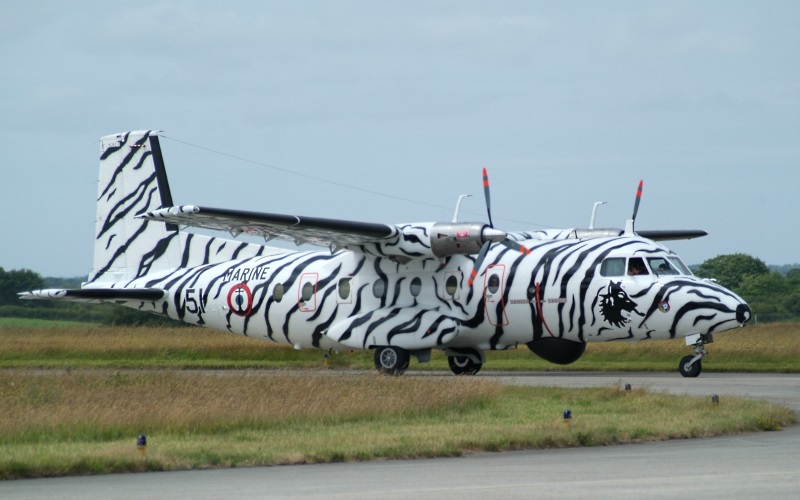
Only 110 N.262s were built up to end of production in 1976, by which time Nord had been absorbed into the Aerospatiale firm. In the mid-1970s, nine N.262As were updated by Frakes Aviation for Allegheny Airlines, being powered by Pratt & Whitney Canada PT6A-45 engines driving five-bladed propellers. They also had avionics to support US regulations. They were redesignated "Mohawk 298".
The N.262 was used by several dozen airlines; along with use by the French military, it was also flown in government-military service by Angola, Burkina Faso, Gabon, and the Republic of the Congo. The N.262 lingered in service into the early 21st century.
BACK_TO_TOP* In the early 1960s, the Soviet state airline Aeroflot was after a replacement for the Antonov An-2 light airliner and utility aircraft. In response, in 1966 the Czechoslovak aircraft manufacturer Let of Kunovice began studies for a twin-turboprop light airliner for local and feeder service, including operations from grass fields, originally designated the "L-400". It was also to be suitable for other roles, such as air ambulance, aerial survey, geophysical survey, radio navigation aids calibration, and navigation training.
After approval for development, the design was refined into the "L-410 Turbolet", with an "XL-410" prototype performing its first flight on 16 April 1969. Four prototypes were built in all; the first two prototypes had three-bladed propellers and high vibration levels, the problem being fixed by introduction of four-bladed propellers in the third prototype. Trials led to the introduction of the production "L-410A" in 1971.
The L-410A provides a baseline for the series. It was a high-wing aircraft, made mostly of aircraft aluminum alloy, with retractable tricycle landing gear, straight two-spar wings, swept tailfin with a small forward fillet, and straight tailplane mounted low on the tailfin. All landing gear assemblies had single wheels and had hydraulic retraction, the steerable nosewheel retracting forward, each main gear retracting sideways into a sponson on each side of the fuselage to lie flat; there were no doors for the main gear. Flight controls were of conventional arrangement -- ailerons, double slotted flaps, elevators, rudder, plus trim tabs -- and manually controlled, except for hydraulically-actuated flaps. All the flight surfaces had de-icing boots, with options for pneumatic or hydraulic actuation.
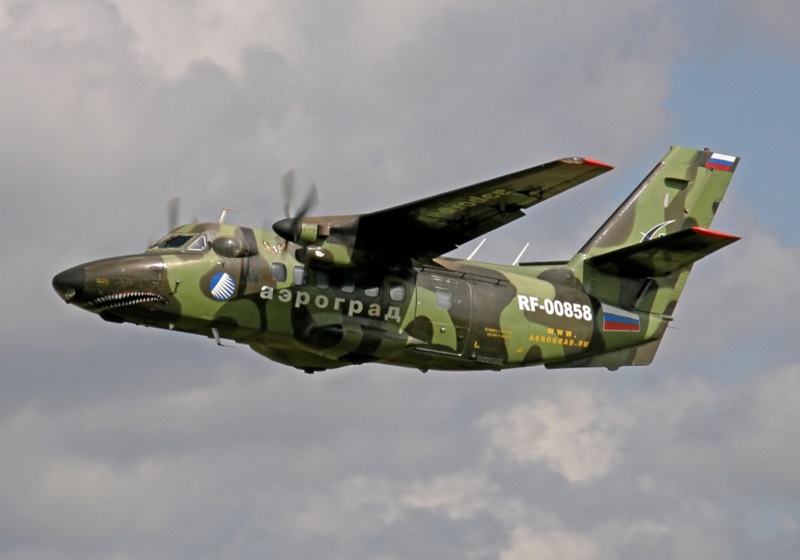
There were two aircrew and seating for from 13 to 17 passengers, with three-across seating. A 12-seat luxury configuration, as well as executive and air ambulance configurations, were also available. Passenger windows were in the form of rounded-off squares. There was an upward-opening double door on the left rear fuselage, the right side of the double door being used as a passenger door, both sides used for cargo loading; plus an emergency exit / crew door, opening downward, on the forward right fuselage. There was a toilet aft, plus baggage holds in the nose, with doors on each side of the nose; there was also a baggage hold in the rear fuselage. The L-410A was unpressurized; it had heating and ventilation, but lacked air conditioning.
Although the intent had been to power the L-410 with Czech Walter M601 turboprops, engine development was delayed, so the prototype, and the initial production L-410A machines, were powered by Pratt & Whitney Canada (PWC) PT6A-27 turboprops, providing 535 ekW (715 EHP), driving three-bladed Hartzell reversible propellers -- it seems the vibration problems had been fixed even without use of four-bladed props. The engine inlets and the props were electrically de-iced. The wings were fitted with eight bag-type fuel tanks, with a total capacity of 1,300 liters (343 US gallons).
___________________________________________________________________
LET L-410A TURBOLET:
___________________________________________________________________
wingspan:
17.48 meters (57 feet 4 inches)
wing area:
32.86 sq_meters (353.7 sq_feet)
length:
13.61 meters (44 feet 8 inches)
height:
5.65 meters (18 feet 6 inches)
empty weight:
3,100 kilograms (6,835 pounds)
max take-off weight:
5,400 kilograms (11,905 pounds)
max cruise speed:
370 KPH (230 MPH / 200 KT)
service ceiling:
7,000 meters (22,975 feet)
range, max fuel:
1,300 kilometers (805 MI / 700 NMI)
range, max payload:
300 kilometers (185 MI / 160 NMI)
___________________________________________________________________
28 production L-410A machines were built, as well as a single "L-410AF" machine supplied to Hungary, this being an aerial survey machine with a glazed nose, accommodating a vertical camera and an operator's position. Oddly the nose wheel was fixed, though the main gear was not; the new nose gave no space for retraction. These were followed by the "L-410M", which had the M601 engines providing 550 ekW (735 EHP) -- along with water-methanol injection to give a 14% short-term power boost -- driving V508 three-blade reversible propellers. Initial flight of the L-410M was in 1973, with initial customer deliveries in 1976, and a total of 110 production machines built.
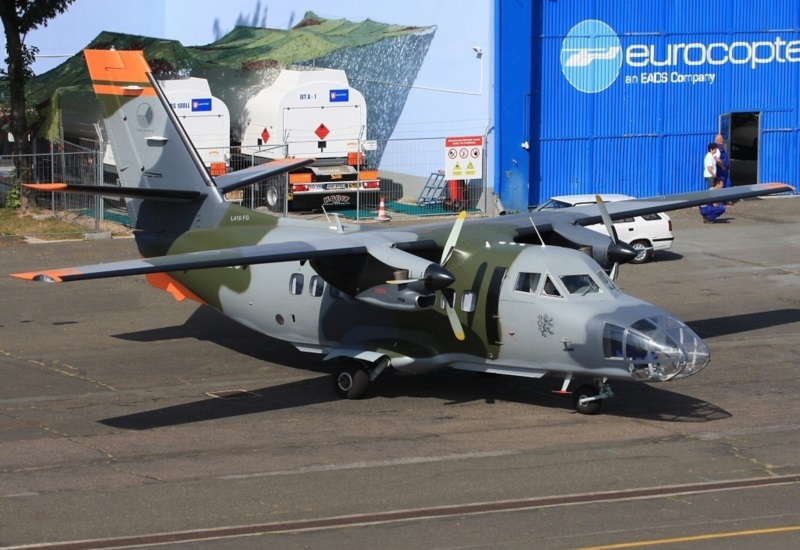
In response to Aeroflot requirements, Let engineers rethought the design, the result being the "L-410UVP", which featured:
Another significant change was to increase operational temperature limits to a range from -50 degrees Celsius (-60 degrees Fahrenheit) up to 45C (113F). Ski landing gear was an option. Other changes included automatic prop feathering, antiskid brakes, plus a redesigned and enhanced cockpit layout. The redesign increased empty weight and shifted the center of gravity, requiring that passenger capacity be reduced to 15 seats.
The L-420UVP could be easily converted to all-cargo, air ambulance, parachutist, or firefighting configuration; it could also be kitted up for air photo survey or as a navigation systems calibration. Initial flight of the first of five L-410UVP prototypes was on 1 November 1977, with 502 production L-410UVPs built to end of manufacture in 1985.
* The L-410UVP was followed in turn by the definitive "L-410UVP-E", which featured an increased maximum passenger capacity of 19 seats -- achieved by re-arrangement of the cabin, toilet, and rear baggage hold -- with a corresponding increase in maximum take-off weight (MTO). It featured more powerful M601E engines, with 560 kW (750 SHP) each -- plus boost power for short periods via water injection -- driving five-bladed reversible V501 propellers. It also featured removeable wingtip tanks with a capacity of 200 liters (40 US gallons) each, increasing range by up to 40%; the wings were reinforced to handle the tip tanks. There were other minor changes in kit as well.
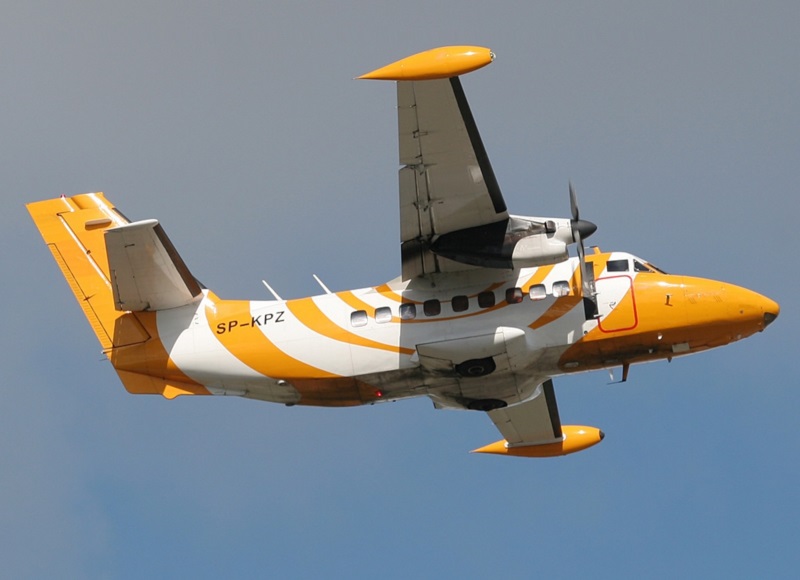
Initial flight was in 1984, with production beginning in 1986. There were tweaky subvariants, including the "L-410UVP-E9" and "L-410UVP-E20", with higher MTO, intended to meet different certifications.
___________________________________________________________________
LET L-410UVP-E TURBOLET:
___________________________________________________________________
wingspan:
19.48 meters (63 feet 11 inches)
wingspan over tanks:
19.98 meters (65 feet 6 inches)
wing area:
34.86 sq_meters (375.2 sq_feet)
length:
14.42 meters (47 feet 4 inches)
height:
5.83 meters (19 feet 2 inches)
empty weight:
3,985 kilograms (8,785 pounds)
MTO weight:
6,400 kilograms (14,110 pounds)
max cruise speed:
380 KPH (235 MPH / 205 KT)
service ceiling:
6,320 meters (20,725 feet)
range, max fuel:
1,365 kilometers (850 MI / 735 NMI)
range, max payload:
560 kilometers (345 MI / 300 NMI)
___________________________________________________________________
The final production version was the "L-420", which was powered by the further improved Walter M601F engine and featured Westernized avionics. There was talk of an "L-430" with PWC PT6A engines and a fuselage stretch, but it didn't happen. A total of 1,100 L-410/420 machines was built in all, most of them flying with Aeroflot; the aircraft being sturdy and reliable, many remain in service.
Indeed, two L-410 UVP E30 machines were obtained by the Polish Border Guards in 2019 in a patrol configuration, featuring a search radar in a belly radome, just forward of the landing gear; a day-night imaging turret under the nose; a satellite communications datalink; an Automatic Identification System (AIS) receiver to identify vessels; and air-droppable rescue kit. These aircraft participated in the Russo-Ukraine War in 2022:23, one of them being attacked by a Russian Su-35 fighter that made very close passes on the L-410, causing it to lose control. The aircrew managed to return to stable flight and return to base.
* Let developed a scaled-up derivative of the L-410, the "L-610". It had much the same general configuration as the L-410. The first prototype performed its initial flight on 28 December 1988, the aircraft being powered by Motorlet M602 engines providing 1,360 kW (1,820 SHP) each.
The L-610 was effectively a new aircraft, with little or no real parts commonality with the L-410. It had a wingspan of 25.6 meters (84 feet), a length of 21.42 meters (70 feet 3 inches), and an empty weight of 8,730 kilograms (19,245 pounds) -- over twice that of the L-410. Along with being bigger, the L-610 differed visibly from the L-410 in having a tee tail.
The fuselage was also longer relative to the wing, permitting accommodation of 40 passengers, in ten four-across rows -- fuselage width was increased to 2.7 meters (8 feet 10 inches) from 2.08 meters (6 feet 10 inches). A combi configuration was offered as well. The Let-610 had a passenger door on the left rear fuselage, a cargo door on the left front fuselage, a service door / emergency exit on the right fuselage across from the passenger door, and emergency exits under each wing. Accommodations were pressurized and climate-conditioned.
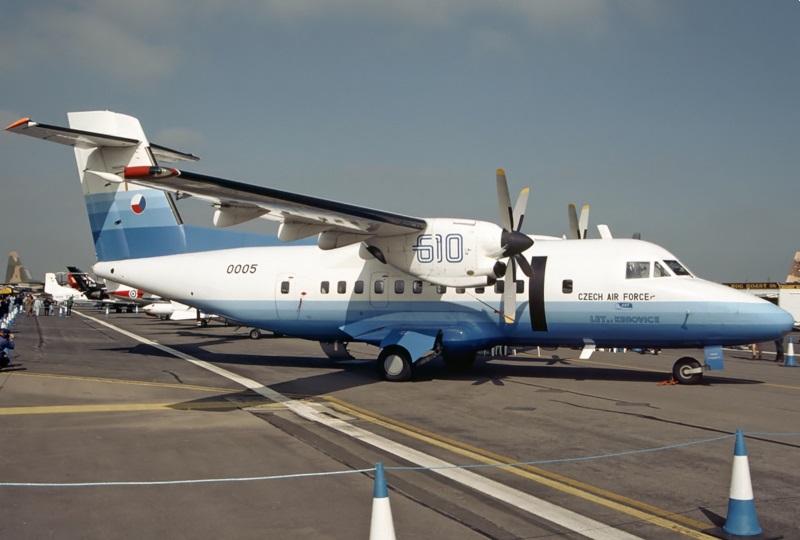
The Let-610 featured integral wing tanks, as opposed to the bag tanks of the L-410. The flight control surfaces were all metal-skinned, being manually actuated, and there were de-icing boots on all the flight surfaces. Seven more machines were built, including two Westernized "L-610G" prototypes with General Electric (GE) CT7-9D turboprops with 1,305 kW (1,750 SHP), and Western avionics. Let was bought out by Ayres Corporation in 1998, which tried to promote the L-610G as the "Ayres 7000", but that plan fell through when Ayres went bankrupt in 2001. What happened to the L-610 prototypes is unclear; photos show some of them ended up in Czech Air Force service.
BACK_TO_TOP* In the early 1980s, the Swedish SAAB AB concern worked with Fairchild Aircraft to develop a twin-turboprop feederliner, originally designated the "SF 340A", the designation in reference to its capacity of 34 passenger seats. The first of three prototypes performed its initial flight on 25 January 1983, with customer deliveries from 1984. After a few dozen machines were built, Fairchild dropped out of the program in 1985, with SAAB taking over and the aircraft redesignated the "SAAB 340A" in 1987.
The SAAB 340A was a low-wing aircraft made mostly of aircraft aluminum alloy, plus some fiberglass and kevlar components. It featured a conventional tail assembly, tricycle landing gear, and a turboprop engine inboard on each wing. The tailplane and the two-spar wings were both of tapered configuration, both with dihedral -- the dihedral being pronounced on the tailplane. The tailfin was distinctly swept, with a prominent forward fillet; there were twin fixed ventral fins under the tail. Flight control surfaces were conventional, including single slotted flaps, ailerons, elevators, and rudder, along with trim tabs. All flight control surfaces were manually actuated, except for hydraulically-driven flaps. There were pneumatic de-icing boots on all flight surfaces.
It was initially powered by two 1,215 kW (1,630 SHP) General Electric (GE) CT7-5A2 turboprop engines, driving four-bladed Dowty Rotol constant-speed / fully reversible / auto-feathering props. From mid-1985, the engines were uprated to 1,295 kW (1,735 SHP), with props of wider span fitted; the engine update could also be obtained for older machines. The engine intakes were electrically de-iced, as well as the props and pitot tubes. Fuel was stored in an integral tank in each outer wing, with total fuel capacity being 3,220 liters (850 US gallons). There was a single-point refueling port in the outboard right wing, with gravity refueling points on top of the wings.
All landing gear assemblies had twin wheels; they all retracted forward hydraulically, the main gear into the engine nacelles. The nose gear was steerable. The cockpit had seats for pilot and copilot, plus a jumpseat for an observer; there was a seat for a flight attendant in the main cabin. Capacity was from 30 to 36 seats, with 35 being the most common configuration, in the configuration of 11 rows of three seats, plus two rearward-facing seats up front. There was a galley, wardrobe, or storage module up front on the left. One rearward-facing seat could be replaced with a galley or wardrobe, or both seats could be replaced by both. Toilet was at the front or rear, depending on customer requirement.
The main baggage compartment was in the rear. The SAAB 340A was built in a combi configuration, with a moveable bulkhead in the rear. The passenger door, which was a fold-down airstair, was on the front left fuselage, with a roll-up cargo door on the rear left fuselage. There was an emergency exit on the right opposite the passenger door, plus emergency exits over each wing, and an escape hatch above the cockpit. The SAAB 340 was also available in VIP and air freighter configurations, with air freighter types including the "SAAB 340AF" pure freighter and "SAAB 340AQC" quick-change passenger-freighter.
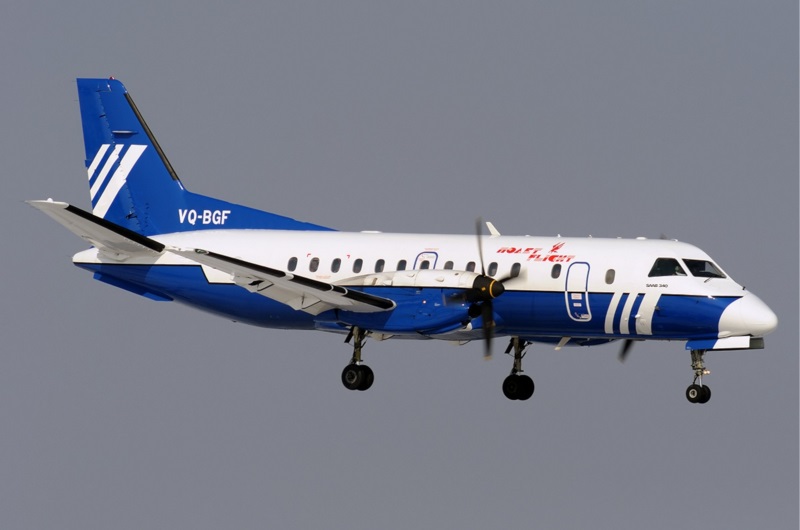
A total of 159 SAAB 340A machines was built, to then be replaced in production by the "SAAB 340B", with more powerful GE CT7-9B turboprop engines with 1,395 kW (1,870 SHP) each, plus a wider tailplane, and optional extended wingtips. Later production also had an active noise cancellation system . 200 340Bs were built, being followed in turn by the "SAAB 340B Plus", with the active noise cancellation system and extended wingtips standard, along with an interior re-arrangement and update. It went into production in 1994, with 100 built to end of production in 1998 -- for total production of 462 SAAB 340s, including prototypes.
___________________________________________________________________
SAAB 340A:
___________________________________________________________________
wingspan:
21.44 meters (70 feet 4 inches)
wing area:
41.81 sq_meters (450 sq_feet)
length:
19.72 meters (64 feet 8 inches)
height:
6.86 meters (22 feet 6 inches)
empty weight:
7,900 kilograms (17,425 pounds)
MTO weight:
12,700 kilograms (28,000 pounds)
max cruise speed:
505 KPH (315 MPH / 270 KT)
service ceiling:
7,620 meters (25,000 feet)
range (economical cruise speed):
1,170 kilometers (725 MI / 630 NMI)
___________________________________________________________________
A number of SAAB 340s were obtained by military and paramilitary services. A maritime patrol / search & rescue (SAR) variant, the "SAAB 340 Maritime Security Aircraft (MSA)", was offered, featuring extended wingtips, a sensor suite including search radar and an imaging turret, plus a removeable long-range auxiliary fuel tank. Two SAAB 340B Plus machines were obtained by the Japanese Coast Guard in the MSA configuration as the "SAAB 340B Plus SAR-200".
The primary service user, however, was the Flygvapnet (Swedish Air Force), which obtained a number of SAAB 340B / 340B Plus machines as VIP transports. They were given the military designations of "Tp 100B" and "Tp 100C" respectively. More significantly, the Flygvapnet obtained six SAAB 340B machines for the "airborne early warning & control (AEW&C)" mission, being designated the "S 100B Argus" in military service. They carried the Ericsson PS-890 Erieye active-array side-looking radar in a beam fairing supported on struts on the back. The radar had a field of view of 150 degrees on each side, and was capable of spotting fighter-sized targets at ranges of up to about 425 kilometers (265 miles).
Enlarged fixed ventral fins were fitted to compensate for the radar module. The S 100B was also fitted with extensive communications kit, an electronic support measures (radio emitter detection & identification) system, a communications intercept system, and a defensive countermeasures system. The Argus could be fitted with four workstations, but typically they relayed radar scans via datalink back to ground stations integrated into the Swedish defense net.
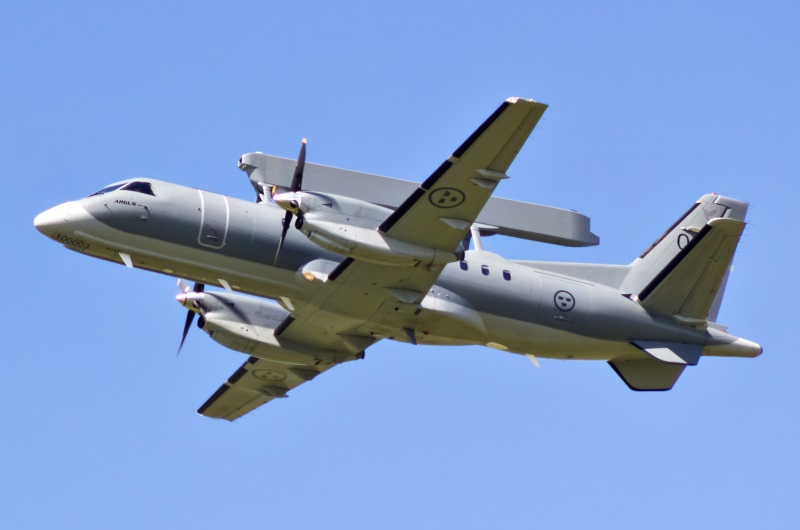
The first of the S 100Bs performed its initial flight in 1994. Only four were kitted up with the radar and other tactical systems; the other two could be equipped with them if need be, but were left in reserve to fly as transports. From 2006, two of the S 100Bs were updated to support multinational operations, the Swedes having become more willing to overtly work along with NATO. Two of the S 100Bs were loaned to Greece for familiarization, pending arrival of Brazilian Embraer ERJ-145 regional airliners in AEW&C configuration, with the Erieye radar.
Thailand bought two S 100Bs, with the first delivered in 2010 and the second in 2012. The United Arab Emirates ordered two in 2009, delivery date being unknown, as an interim solution before obtaining the SAAB "GlobalEye", using the Bombardier Global 6000 bizjet to carry the Erieye radar. The two UAE S 100Bs were passed on to Poland in 2024. Two of the Swedish S 100Bs were transferred to Ukraine in 2025, with Ukrainian F-16s modified to ensure intercommunications with the radar platforms. Sweden was phasing the S 100Bs out pending deliveries of the GlobalEye platform.
In 2020, Cranfield University of the UK, a widely-known center for aerospace engineering, obtained a Saab 340 for use as a "flying classroom", as well as a "flying laboratory". Cranfield had a long-standing relationship with Saab, with Saab refurbishing the aircraft for its new role.
BACK_TO_TOP* In 1988, SAAB management committed to development of a stretched, high-performance derivative of the SAAB 340, with the first "SAAB 2000" prototype performing its initial flight on 26 March 1992, and introduction to service in 1994.
The SAAB 2000 was 7.55 meters (24 feet 9 inches) longer than the SAAB 340, giving maximum seating of 58 passengers, and had wingspan extended by 15%. It was powered by Allison -- later Rolls-Royce Allison -- AE 2100 turboprop engines, with 3,425 kW (4,590 SHP) each, turning six-bladed scimitar-blade propellers from Dowty Rotol. The engines were moved out on the wing to reduce cabin noise. The tailfin was taller and bigger as well. Avionics were updated, including a Collins Pro Line 4 glass cockpit and an active noise cancellation system.
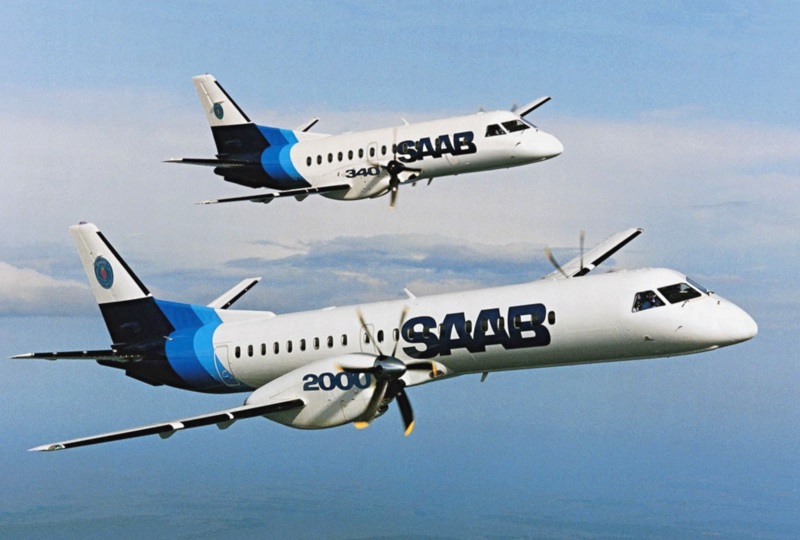
Otherwise, the SAAB 2000 was generally similar to the SAAB 340, with the same flight control surfaces, though the elevators and rudder were electrically driven; and the same landing gear arrangement, though the gear was reinforced. The wing fuel tanks were enlarged to a total capacity of 5,300 liters (1,400 US gallons). Default seating was 50 seats, in an updated interior, which was also used in the SAAB 340B Plus, as above. The rear bulkhead could be moved back to handle 8 more, for a total of 58. There was a toilet in front and a galley in the rear. Door arrangement was much the same as that of the SAAB 340, except the forward right emergency exit was deleted, and a right rear service door / emergency exit added.
___________________________________________________________________
SAAB 2000:
___________________________________________________________________
wingspan:
24.76 meters (81 feet 3 inches)
wing area:
55.7 sq_meters (600 sq_feet)
length:
27.28 meters (89 feet 6 inches)
height:
7.73 meters (25 feet 4 inches)
empty weight:
13,800 kilograms (13,800 pounds)
MTO weight:
22,800 kilograms (50,265 pounds)
max cruise speed:
665 KPH (425 MPH / 370 KT)
service ceiling:
9,450 meters (31,000 feet)
range:
2,185 kilometers (1,355 MI / 1,180 NMI)
___________________________________________________________________
The SAAB 2000 simply didn't sell, being overtaken by regional jets like the Bombardier CRJ and EMBRAER ERJ 145. Only 63 SAAB 2000s were built to end of production in 1999.

Pakistan obtained four kitted up like the Argus S 100B, carrying Erieye radar, with deliveries in 2009:2010, for use as AEW&C platforms. They didn't have the enlarged ventral fins, but they did have fairings on the wingtips and tailfin tip, suggesting modernized equipment fit. Pakistan later obtained more, to a total of nine. Other military configurations, for maritime patrol or dedicated signals intelligence, were also offered, but it doesn't appear anyone obtained them.
BACK_TO_TOP* Primary sources for this document were a number of volumes of JANE'S ALL THE WORLD'S AIRCRAFT, as well as:
The online Wikipedia was consulted as well. These aircraft are not over-documented.

* Revision history:
v1.0.0 / 01 aug 17 v1.0.1 / 01 jul 19 / Review & polish. v1.2.0 / 01 jul 21 / Illustrations update. v1.2.1 / 01 jun 23 / Review & polish. v1.2.2 / 01 jun 25 / Review & polish. (!)BACK_TO_TOP
